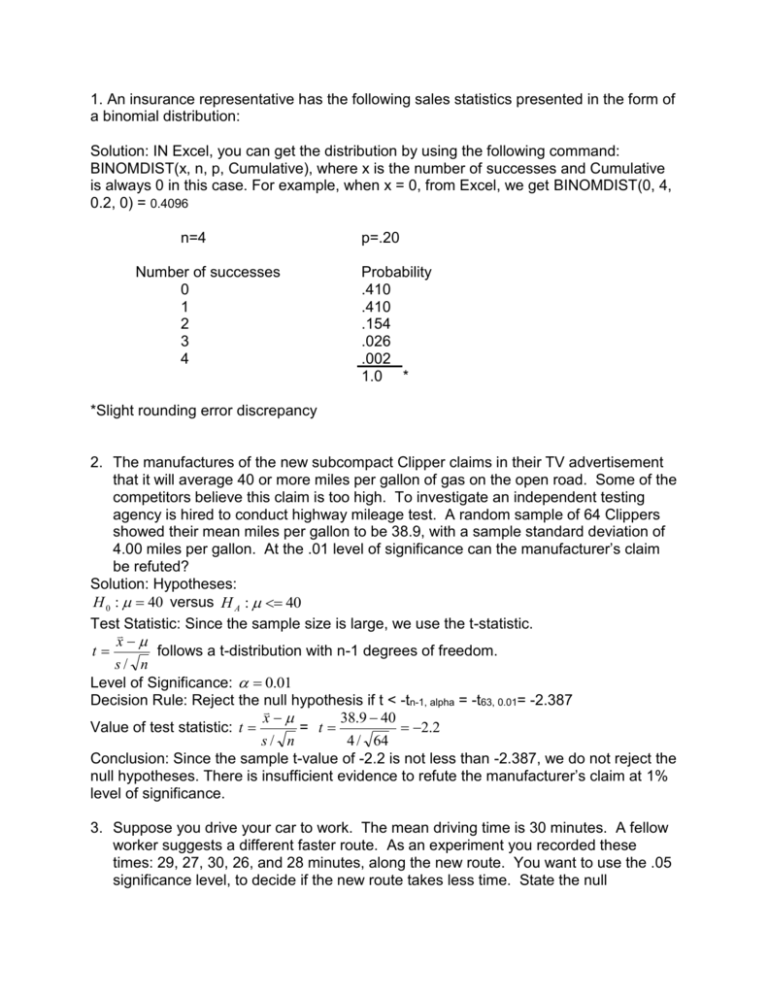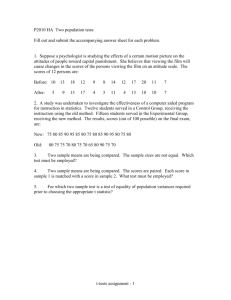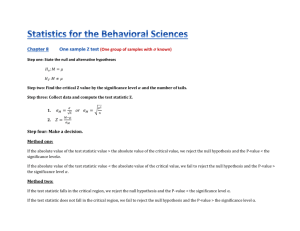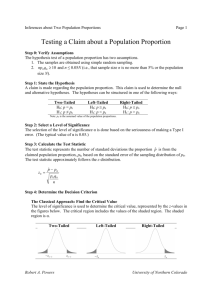1 - Mathfiles.com
advertisement

1. An insurance representative has the following sales statistics presented in the form of a binomial distribution: Solution: IN Excel, you can get the distribution by using the following command: BINOMDIST(x, n, p, Cumulative), where x is the number of successes and Cumulative is always 0 in this case. For example, when x = 0, from Excel, we get BINOMDIST(0, 4, 0.2, 0) = 0.4096 n=4 Number of successes 0 1 2 3 4 p=.20 Probability .410 .410 .154 .026 .002 1.0 * *Slight rounding error discrepancy 2. The manufactures of the new subcompact Clipper claims in their TV advertisement that it will average 40 or more miles per gallon of gas on the open road. Some of the competitors believe this claim is too high. To investigate an independent testing agency is hired to conduct highway mileage test. A random sample of 64 Clippers showed their mean miles per gallon to be 38.9, with a sample standard deviation of 4.00 miles per gallon. At the .01 level of significance can the manufacturer’s claim be refuted? Solution: Hypotheses: H 0 : 40 versus H A : 40 Test Statistic: Since the sample size is large, we use the t-statistic. x follows a t-distribution with n-1 degrees of freedom. t s/ n Level of Significance: 0.01 Decision Rule: Reject the null hypothesis if t < -tn-1, alpha = -t63, 0.01= -2.387 38.9 40 x Value of test statistic: t = t 2.2 4 / 64 s/ n Conclusion: Since the sample t-value of -2.2 is not less than -2.387, we do not reject the null hypotheses. There is insufficient evidence to refute the manufacturer’s claim at 1% level of significance. 3. Suppose you drive your car to work. The mean driving time is 30 minutes. A fellow worker suggests a different faster route. As an experiment you recorded these times: 29, 27, 30, 26, and 28 minutes, along the new route. You want to use the .05 significance level, to decide if the new route takes less time. State the null hypothesis, the alternative hypothesis, and the degrees of freedom in this test. What is the critical value of the test statistic? Determine the mean and standard deviation of the sample and use the test statistic to determine if you accept or reject the null hypothesis. Solution: Hypotheses: H 0 : 30 min utes versus H A : 30 min utes Test Statistic: Since the population standard deviation is unknown, we use the t-statistic. x follows a t-distribution with n-1 degrees of freedom. t s/ n Level of Significance: 0.05 Decision Rule: Reject the null hypothesis if t < -tn-1, alpha = -t4, 0.05 = -2.132 Calculations: Mean = Stdev = 29 27 30 26 28 28 1.581139 Value of test statistic: t x = t 28 30 2.829 1.5811 / 5 s/ n Conclusion: Since the sample t-value of -2.829 is less than the critical t-value of -2.132, we reject the null hypotheses. There is sufficient evidence to conclude at 5% level of significance that the alternative route is faster. 2. Teledko Associates is a marketing research firm that specializes in comparative shopping. Teledko is hired by General Motors to compare the selling price of the Pontiac Sunbird with the Chevy Cavalier. Posing as a potential customer, a representative of Teledko visited 8 Pontiac dealerships in Metro City and 6 Chevrolet dealerships in the same city and obtained quotes on comparable cars. The standard deviation for the selling price of the 8 Pontiac Sunbirds is $350 and on the six Cavaliers, $290. At the .02 level of significance is there a difference in the variation of the quotes of the Sunbirds and the Cavaliers? Solution: Hypotheses: H0 : 12 12 1 H : 1 versus A 22 22 Test Statistic: We use the F-statistic F = s12 with n1-1 and n2-1 degrees of freedom s 22 Level of Significance: 0.02 Decision Rule: Reject the null hypothesis if F F / 2,n11,n 21 F0.01, 7 ,5 10.45555 s12 350 2 Value of test statistic: F 2 1.4566 s 2 290 2 Conclusion: Since the sample F-value of 1.4566 is not greater than critical F-value of 10.4555, we do not reject the null hypotheses. There is insufficient evidence to conclude at 2% level of significance that there exists a difference in the variation of the quotes of the Sunbirds and the Cavaliers. 5. The owner of a mail-order catalog would like to compare her sales with the geographic distribution of the population. According to the United States Bureau of the Census, 21 percent of the population lives in the Northeast, 24 percent in the Midwest, 35 percent in the South, and 20 percent in the West. Listed below is a breakdown of a sample of 400 orders randomly selected from those who shopped last month. At the .01 significance level, does the distribution of the orders reflect the population? Region Frequency Northeast 68 Midwest 104 South 155 West 73 Total 400 Solution: This is a problem of Chi-Squared test of goodness of fit. Hypotheses: H 0 : The percentages of the shopping populations are as listed according to the United States Bureau of Census, versus H A : At least two of the percentages are different. Test Statistic: We use the 2 -statistic 4 2 Oi ei 2 ei Level of Significance: 0.01 Decision Rule: Reject the null hypothesis if 2 2 ,n1 = 2 0.01,3 = 11.34488 Value of test statistic: We construct the following table: i 1 k 1 2 3 4 Sums: Obsd. Freq. 68 104 155 73 400 Sample 2 0.0148348 Oi 0.17 0.26 0.3875 0.1825 1 ei 0.21 0.24 0.35 0.2 1 Oi-ei -0.04 0.02 0.0375 -0.0175 (Oi-ei)^2 0.0016 0.0004 0.001406 0.000306 (Oi-ei)^2/ei 0.007619 0.0016667 0.0040179 0.0015313 0.0148348 Conclusion: Since the sample 2 -value of 0.0148348 is not greater than critical 2 value of 11.34488, we do not reject the null hypotheses. Thus we can conclude that at 1% level of significance, the distribution of the orders indeed reflects the population.









